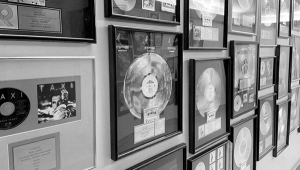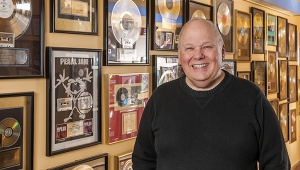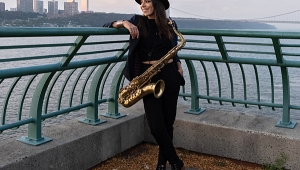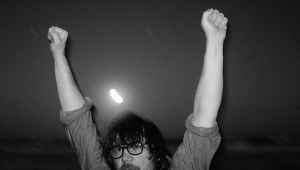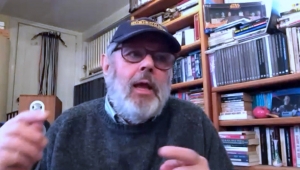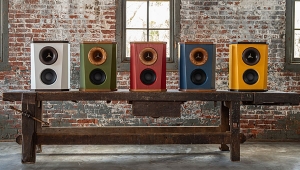| Columns Retired Columns & Blogs |
John Bau: Interstellar Overdrive
Elsewhere in this issue, I review the new Spica Angelus loudspeaker, only the fourth product to appear from this Santa Fe-based manufacturer since it started operations at the end of the 1970s. You will have to read the review to learn what I thought of the speaker, a distinctively styled floor-standing two-way, but I also thought it would be beneficial to talk with Spica's founder and chief engineer John Bau. I therefore made arrangements to meet with him in their facility just a couple of blocks from Stereophile's old Early Street HQ. I had been told that John was tall, but until he unfolded himself from his stool in his laboratory, surrounded by computers and computerized test equipment, I had not realized how tall! Undaunted, I settled into a conventional chair, pointed the microphone in a vaguely upward direction, and asked John how he had gotten into loudspeaker design.—John Atkinson
John Bau: I've been a musician since I was 12 years old—I play acoustic guitar and bass—and after a certain point, I got more interested in studio work. By 1976 or '77, I was working in a recording studio in Albuquerque. It was a pretty nice facility, considering it was in Albuquerque—it had two 16-track recorders. When you listen to an instrument in the studio, you move your head around to get the sweet spot and you place a microphone on the instrument, but when you go back into the control room and listen to what's coming out, it isn't the same. I mean, the disparity between the live and the reproduced was pretty awful.
Obviously I wanted to make to some improvements to the system that was in the studio! The weakest links in the chain are the mechanical to electrical transitions; ie, the microphones and speakers. Well, microphones were a whole level of technology that I couldn't really apply myself to without specialized knowledge—I don't have any training or degrees in audio engineering, although I'm not afraid of playing around with electronics—so I ended up playing around with loudspeakers. I was fortunate enough, I guess you might say, that the person I was working for was very stubborn, very set in his ways, and would not let me experiment with the studio speakers. I had to start doing it on my own. So I went out and bought a reasonably priced pair of speakers, I think it was a pair of Advents or something, and just started playing around with them, seeing what changed what.
After a few years, I got involved in a project producing and playing on an album that required that I go to a number of different studios around the country in order to utilize the talents of various people who couldn't come to New Mexico. I needed, therefore, a pair of lightweight compact speakers that I could haul around with me; I've been in enough studios to know that they all sound different, and I didn't want to have to keep making adjustments when I went to Studio X or Studio Y in Nashville. I wanted something that I could take with me that I could trust—a transportable monitor. I had been playing around with this tubular material, so the result was the first Spica loudspeaker, the SC50. (People used to say that this was reminiscent of the little JR 149, the semi-cylindrical thing with endcaps, although I had never seen a pair.)
All this work was being done by ear; I had a voltmeter, but I didn't have a microphone. I was renting a house in the little town of Madrid, near Santa Fe, and because the room sounded awful, I would stick a pair of the speakers out in front of the house. There was quite a bit of tourist traffic through town, and people would stop: "Hey, those sound good, how much do you want for a pair?" So I'd end up selling four or five pairs a month. Part of me said, "Hmm, this is interesting. It's a nice little income on the side." However, then the funding for our project got cut off, I parted company with the person I was working under, and I decided that I'd had it with music; trying to make my living in the bars and in the studios wasn't working very well. It therefore felt fairly natural to explore the speaker thing. The amount of money necessary horrified me, but a few months later I got married and my wife's mother gave me a gift of enough money to buy all the materials to do 50 to 100 pairs of speakers.
This was in 1978. My intention was to sell the SC50 to friends and to market it through local dealers and hope to make a go of it. I was doing okay selling them to people I knew, but Santa Fe isn't that large a town; the dealers would all say, "Well, here's a local boy trying to make a go of it. Good luck. But we can't really help you." It was getting pretty much down to the wire—something had to happen or it wasn't going to work—when a friend told me about PS Audio, who had started their company a couple of years prior. I really didn't know anything about the hi-fi industry, so I called them. They asked if I was going to the Show? "What Show?" I said. "The CES!", they said; "If you're not there, you have no hope." I immediately called CES, who put me on the waiting list for the June 1979 show in Chicago. Things were getting grimmer and grimmer, but then, three days before the show, I got a call from CES and they said that as ESS had just bought out Dynaco, Dynaco's room on the fourth floor of the Americana Congress was open. Would I like it? "By all means," I said.
So I packed up my pair of SC50s in my little Opel Cadet and drove to Chicago. I was just astounded by the size of the companies and the whole scene there. I had to borrow a stereo system because all I had as my reference was my Revox A77 recorder that was in pretty sad shape. (Although the good side of it was that I had some good microphones and I was using live recorded material.) I was only able to stay at the show for three to four days, because my wife was giving birth to our child while I was gone, but I obtained about 30 dealers. People were really amazed at what was coming out of this little speaker, so I was obviously just in seventh heaven. From that very beginning year, Spica was profitable. It looked like it was going to fly, so I obtained another loan and bought what I felt were necessary tools. I bought an FFT spectrum analyzer, because one of the things that I realized early on was that the disparity between the various loudspeaker systems that I had looked at was not explainable by the differences in their amplitude responses.
- Log in or register to post comments

